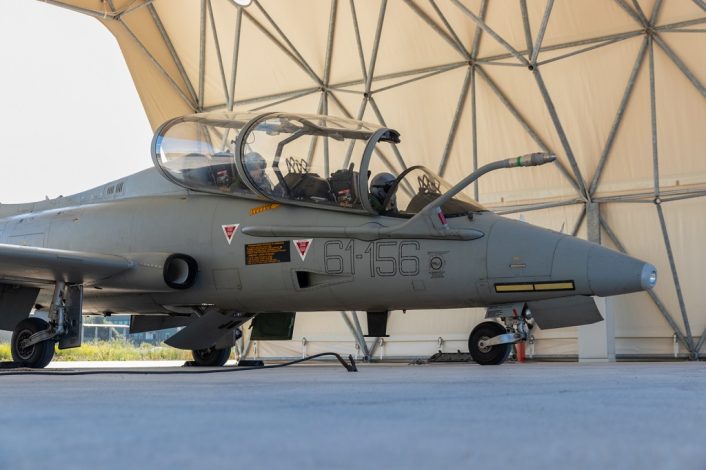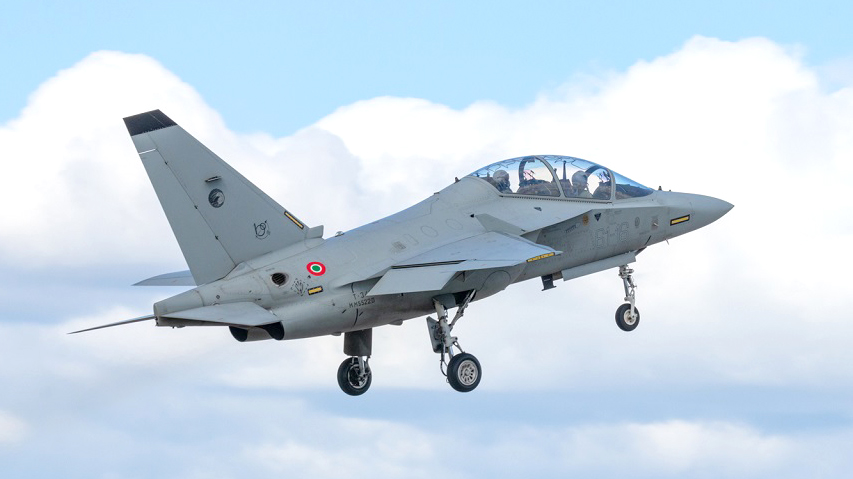The 10-year deal covers the entire syllabus from the basic jet training to the lead-in fighter training.
The chief of the Swedish Air Force, Maj. Gen. Jonas Wikman, and the chief of the Italian Air Force, Lt. Gen. Luca Goretti, signed on Dec.4, 2023, an agreement that will allow Sweden to train future pilots in Italy for the next decade. About 100 student pilots and 10 instructors will be constantly included in the training courses of the Italian Air Force from the Primary Pilot Training of Phase II up to the Lead-In Fighter Training Phase IV.
A date for the beginning of the training of Swedish pilots has not been provided, however it has been confirmed that it will be carried out at both Lecce-Galatina Air Base, where the Phase II and III of the training are usually performed, and at Decimomannu Air Bases, where the Phase IV has been recently relocated with the ItAF-Leonardo joint International Flight Training School. Sweden, thus, joins a large group of countries that over the last few years have already chosen Italy for flight training, convinced by the excellence of the offer and training structures: Austria, Canada, Germany, Japan, Qatar, Singapore, United Kingdom, Saudi Arabia and Kuwait.
“This is a further significant step for the safety of European skies: finding agreements and synergies between countries that share spaces and orientations is always productive. Working with Swedish colleagues will represent an opportunity for growth for both countries,” said Gen. Goretti. “This agreement also represents another fundamental piece for the IFTS project, in which the Country System is investing with trust, conviction and, above all, results. A project born thanks to the full and convinced support of the Ministry of Defense and which is also based on the profitable and proven synergy with Leonardo.”
The explicit mention of the Phase III training at Galatina AB and Phase IV at Decimomannu AB means that the agreement covers the training of future fighter pilots. In fact, as we explained earlier this year after our visit to Galatina AB, the Phase II is common for all future military pilots after the Academy, with the students joining the 61° Stormo and flying the MB-339A for the Primary Pilot Training.
During this phase, pilots are continuously evaluated for the choice of their future assignment aircraft, as Phase III is different based on what type of aircraft will be assigned to the pilots. Pilots assigned to tactical jets stay in Galatina, where they continue with the Specialized Pilot Training on the MB-339CD and, upon graduation, obtain the Military Pilot License. Then, they continue with the Phase IV or Lead In to Fighter training in Decimomannu, flying the T-346.

Summarizing, students that have never flown jets arrive at the 61st Wing and, after 2 years of training, they are ready to move on to high performance fighter jets in operational scenarios. In order to complete the training syllabus for the fighter role and be assigned to the Tornado, Eurofighter, F-35 or (in Sweden’s case) the Gripen, the student needs a total of 30 months of training, which include about 255 flight missions, for a total of 318 flight hours, and 166 simulator sessions, for a total of about 178 hours.
With the agreement having a duration of 10 years, Swedish pilots will start their training in Italy with the MB-339 and later one move to the T-345. In the last 40 years, the MB-339 “Macchino” graduated 2,500 pilots and flew for 400,000 hours. Even if it’s closing to the end of its service life, the MB-339 continues to demonstrate itself as an exceptional, safe, reliable machine, and is still used in the “analog” A variant for the Phase 2 and in the “digital” CD variant for the Phase 3.
The MB-339 is now about to be replaced by the new T-345 High Efficiency Trainer. The T-345 is the new basic jet trainer of the Italian Air Force and will gradually replace the entire MB-339 fleet, beginning from the A variant and later continuing with the CD variant. In fact, thanks to its characteristics, the aircraft can be used for the entire training syllabus, from the Primary Pilot Training to the Specialized Pilot Training.
The T-345 will bring multiple advantages. Similarly to the M346, the new aircraft will be part of an integrated netcentric system, which will allow to shrink the time needed for the training while improving its quality and efficiency. The T-345 trainer offers performance typical of a jet aircraft, such as the maximum altitude and speed, with operational costs comparable to the ones of a turboprop aircraft.









